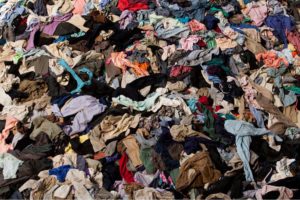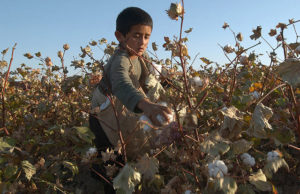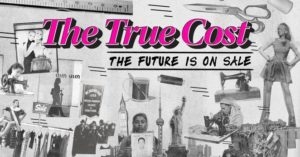It was Wednesday April 23, 2013, Indian television broadcasts show critical structural damage in the Rana Plaza garment factory resulting in the over three thousand workers being evacuated. Later the same day, the factory owner, Sohel Rana told the media that was the building safe, and factory managers stated that if workers did not show up for work the next day, that they would be docked a month’s pay. The following day, as workers filled the factory with the proverbial “knife to their throat”, the building collapsed killing 1,130 and injuring roughly 2,500 more.
Details of this devastating tragedy unfolded quickly, illegal floors added to the building, greedy owners, blind eye by international corporations, and ignorance of shoppers looking for a cheap deal-of-the-day.The magnitude of the collapse alone immediately made international news, but this tragic disaster touched the world for another reason: each of us was connected to these workers, they were making our clothes.
Fast Fashion
The average American throws away a shocking 80 pounds of clothing a year. 80 pounds a  year! (I wish I could put that statistic up on billboards around the country with a picture of the collapsed Rana Plaza) We now buy five times the amount of of clothing that we did in the year 1980. But, you give your clothing to charities right? Charities have become inundated, literally clothing dumps overwhelmed by our disposable mentality creating a culture in which less than 20% of donated clothing will end up in a thrift shop or used by the homeless.
year! (I wish I could put that statistic up on billboards around the country with a picture of the collapsed Rana Plaza) We now buy five times the amount of of clothing that we did in the year 1980. But, you give your clothing to charities right? Charities have become inundated, literally clothing dumps overwhelmed by our disposable mentality creating a culture in which less than 20% of donated clothing will end up in a thrift shop or used by the homeless.
Fast Fashion. Maybe you have heard the term? Fast fashion delivers the newest fashions each season, or even more frequently, year after year. Stores like H&M and Target are known for even more aggressive fashion turnover, but why? Why do we need new “fashion” every few months when our closets and drawers are already overflowing? Isn’t quality fashion timeless? Big clothing brands don’t want want us to think so, their message is that clothing is a thing of the moment, another disposable commodity.
Bottom line? We buy like cheap and don’t stop to consider the consequences. Three pairs of socks for $10.99, “Great, who cares if they last 6 months?” A $12.99 dress, “I bought it… but I never wore it.” I could go on all day because I have been there, we all have.
Cheap?
A common theme in the Living to Smile blog is the high cost of cheap food. Let’s look at cheap clothing. Cheap clothes have an incredible cost on human lives, our health, and environmental impact. “Buy 1 get another 50% off”. “$99, Your Cost $29”. “75% off End of Season Clearance”. We know these deals, we love these deals, but do we ever stop to consider their impact?
It’s the factory owner’s fault. It is the big corporations fault. It is the system. Right? But it isn’t our fault, right? We are just part of the system after all. Not so fast. Ignorance is bliss, and it is time to end that ignorance. The “bliss” of ignorance is not an excuse, everything cheap has a huge cost. We need to all be aware that cheap clothes and cheap food are killing us, the global community, and the environment.
Cheap Clothes Cause Cancer and Birth Defects
 BT Cotton is a Monsanto genetically modified cotton used to make low-cost apparel. It has been genetically modified to create a pesticide that fights the bollworm, a moth that attacks cotton. There is a lot of talk these days about GMO. Are GMO foods harmful for us? And even if we might not want to eat GMO foods, why does it matter if clothes are made by GMO plants?
BT Cotton is a Monsanto genetically modified cotton used to make low-cost apparel. It has been genetically modified to create a pesticide that fights the bollworm, a moth that attacks cotton. There is a lot of talk these days about GMO. Are GMO foods harmful for us? And even if we might not want to eat GMO foods, why does it matter if clothes are made by GMO plants?
In one village in India where BT cotton is grown, over 60 mentally handicapped children have been born. Cancer rates are through the roof, and in India there have been 250,000 suicides by farmers, about one every 30 seconds. Meanwhile, Monsanto thrives, selling their toxic products that catch farmers in a viscous cycle of debt, cancer, birth defects, and death. All so that we can get a deal.
Modern GMO is a monster. GMO is primarily a beast monopolized by Monsanto to create ownership and control. Let’s look at how it works. Seeds are created that have a useful property, such a defeating the bollworm, or bigger yields. Sounds great right? Monsanto then sells the patented seeds, often at such enormous cost to the farmer that debt is created. But here is where the true evil kicks in… the crops are then dependent on toxic, often carcinogenic, pesticides such as Roundup. Guess who makes the pesticides? Monsanto. Guess who gets the cancers? The farm workers. Cheap clothes? Cheap food? Not at all.
Monsanto and other chemical companies will point to the way their products are revolutionary. “Big yields”, “drought-resistant”, “Mold resistant”, “feeding the planet”, “cure for starvation”. At what cost? Ignorance is bliss.
What We Can Do
Recently a representative of the a state farm bureau told me that “organic is a marketing ploy”. Wake up America, the “marketing ploy” is by those profiting off cheap food and clothing. There is an answer to this madness, support fair trade and organic agriculture. Want to change the way you think about clothing? Watch ‘The True Cost’, where it is said that “Fair trade is a citizen’s response to social justice in international trading system that is dysfunctional.” So true. We need to vote with our wallets and not buy disposable junk that causes death, hardship, and destruction. We need to realize that every purchase we make is directly connected to the human hands and the Earth.
But the system will never change right? Wrong. The Internet and social networking provide each of us an arsenal to fight for change. After you watch ‘The True Cost’ and other powerful documentaries such as ‘Food Inc.‘, spread the word. Tell your friends and family, post on Facebook, shout out on Twitter, share: that those deals we all think are so fabulous are hurting someone.
When we look at the cost of making morally sound purchasing decisions, there is a cost. But, what is the cost of not doing the right thing? Together we can change a system by making every a purchase a vote for positive change. We can do better.

‘The True Cost’ is available on Netflix, Amazon, Apple tv, or can be downloaded through the truecostmovie.com.
“A portrait of exploitation” – The New York Times
“Gut-wrenching and alarming” – Elle Magazine
“A sweeping, heartbreaking and damning survey of the clothing industry” – CNN



